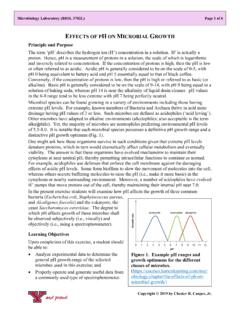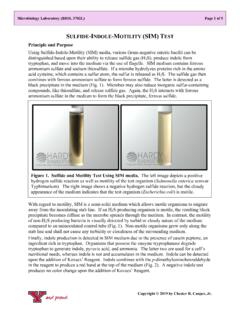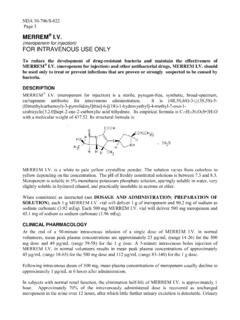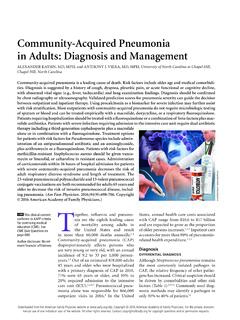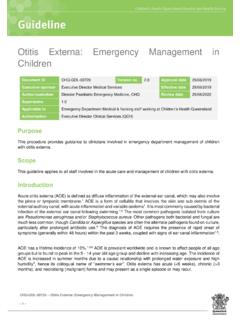Transcription of EFFECTS OF TEMPERATURE ON MICROBIAL GROWTH
1 Copyright 2019 by Chester R. Cooper, Jr. Microbiology Laboratory (BIOL 3702L) Page 1 of 6 EFFECTS OF TEMPERATURE ON MICROBIAL GROWTH Principle and Purpose Each species of microbe can grow within a range of temperatures as determined by its ability to resist the damaging affects of heat or cold to its molecular components ( , ribosomes, membranes, enzymes, etc.). Hence, microorganisms possesss what is termed cardinal temperatures regarding the minimum, maximum, and optimum GROWTH responses. The minimum GROWTH TEMPERATURE is the lowest TEMPERATURE at which a microbe can grow, whereas the maximum GROWTH TEMPERATURE is the highest TEMPERATURE at which a microbe can grow. The optimum GROWTH TEMPERATURE is that at which the rate of cellular reproduction is most rapid. Microbes can be categorized based upon the ranges of their GROWTH temperatures . Figure 1 graphically depicts some of these categories.
2 Typically, there are five categories: Psycrophiles grow well at 0 C and have an optimum GROWTH TEMPERATURE near 15 C; Psycrotrophs, also termed psychrotolerant, prefer cooler environments (4 C to 25 C); Mesophiles grow at temperatures approximately 20 C to 45 C; Thermophiles grow at optimum temperatures of 50 C to a maximum of 80 C; and Hyperthermophiles are characterized by GROWTH ranges from 80 C to 110 C, with some species able to survive temperatures above 121 C. Knowing the range of TEMPERATURE tolerance of various microbes has practical applications. For example, most infectious agents of humans would exist as mesophiles since normal body TEMPERATURE is approximately 37 C. Fever is part of the innate immune system that uses TEMPERATURE to help quell infections. Also, many processes for sterilizing materials employs heat. Organisms that produce endospores ( , many species of Bacillus) require not just heat, but also pressure to kill them.
3 Endospores are notoriously resistant to heat. In addition, many of our food products, particularly dairy, are contaminated with microbes that can be killed by heat. However, the use of high heat can destroy dairy products. Hence, the use of mild heat of about 100 C ( , pasteurization) was developed to help reduce MICROBIAL contamination of foodstuffs. A separate process, termed tyndallization, repeatedly heats then cools substances. This method destroys endospore-forming bacteria. In the present exercise students will examine how TEMPERATURE affects the GROWTH of four bacteria - Escherichia coli, Geobacillus (formerly Bacillus) stearothermophilus, Staphylococcus aureus, and pseudomonas aeruginosa . The degree to which TEMPERATURE affects the GROWTH of these microbes shall be Figure 1. GROWTH rates of microbes as a function of TEMPERATURE . Microbes can be differentiated based upon their ranges of TEMPERATURE tolerance.
4 @5/ TEMPERATURE -and- MICROBIAL - GROWTH ) Copyright 2019 by Chester R. Cooper, Jr. EFFECTS of TEMPERATURE on MICROBIAL GROWTH , Page 2 of 6 observed subjectively ( , visually) and the general range of TEMPERATURE tolerance determined from the data obtained. Learning Objectives Upon completion of this exercise, a student should be able to properly analyze data to determine the general TEMPERATURE GROWTH range of selected microbes. Materials Required The following materials are necessary to successfully conduct this exercise: Organisms The following organisms should be provided as 24-48 hour-old TSA slant cultures: o Escherichia coli (ATCC 25922) [abbreviated as E. coli] o Staphylococcus aureus (ATCC 25923) [abbreviated as S. aureus] o Geobacillus stearothemophilus (ATCC 7953) [abbreviated as G. stearothemophilus] Endospore suspension of Bacillus subtilis (ATCC 6633) [abbreviated as B.]
5 Subtilis] Materials Sterile bulb transfer pipettes Sterile saline (5 ml) in standard test tube TSB (3 ml) in 13 x 100 mm tubes Wickerham card Equipment 55 C heat block incubator (including heat block for 13 x 100 mm tubes) 85 C heat block incubator (including heat block for 13 x 100 mm tubes) 100 C heat block incubator (including heat block for 13 x 100 mm tubes) Procedures Students shall review and use the BIOL 3702L Standard Practices regarding the labeling, incubation, and disposal of materials. 1) Obtain four test tubes containing 5 ml of sterile saline. Label one tube as E. coli, the second as G. stearothermophilus, the third as S. aureus, and the remaining tube as B. subtilis. 2) Obtain twenty-eight (28) 13 x 100 mm tubes of TSB. Label four tubes each as follows: 4 C, 25 C, 37 C, 55 C, 85 C, 100 C, and control . 3) Label a series of seven (7) TSB tubes (consisting of one tube each labeled 4 C, 25 C, 37 C, 55 C, 85 C, 100 C, and control ) as E.
6 Coli. Label another series of seven (7) tubes as G. stearothermophilus, a third series of seven (7) tubes as S. aureus, and the remaining series of seven (7) tubes as B. subtilis. 4) To the saline tube labeled E. coli, aseptically transfer a loopful of GROWTH from the TSA culture of E. coli. 5) Similarly, aseptically transfer a loopful of GROWTH from the cultures of G. stearothermophilus and S. aureus to the respectively labeled saline tubes. Copyright 2019 by Chester R. Cooper, Jr. EFFECTS of TEMPERATURE on MICROBIAL GROWTH , Page 3 of 6 Note: The B. subtilis endospores are already provided as a suspension that is ready to use. 6) Thoroughly mix the E. coli saline suspension thoroughly by rolling the tube between both palms ten times or more. Roll the tube quickly, but not so harshly that the broth splashes onto the tube cap or such that the tube rolls out of the hands causing leakage or breakage.
7 7) Using a sterile bulb transfer pipette, inoculate each of six (6) E. coli-labeled TSB tubes in a TEMPERATURE series with ml of the E. coli saline suspension. The seventh TSB tube labeled control should be left uninoculated. This tube will serve as the sterility control. 8) Thoroughly mix the G. stearothermophilus saline suspension as described in Step 6. 9) Using a new sterile bulb transfer pipette, inoculate each of six (6) G. stearothermophilus-labeled TSB tubes in a TEMPERATURE series with ml of the G. stearothermophilus saline suspension. The seventh TSB tube labeled control should be left uninoculated. This tube will serve as the sterility control. 10) Thoroughly mix the S. aureus saline suspension as described in Step 6. 11) Using a new sterile bulb transfer pipette, inoculate each of six (6) S. aureus-labeled TSB tubes in a TEMPERATURE series with ml of the S.
8 Aureus saline suspension. The seventh TSB tube labeled control should be left uninoculated. This tube will serve as the sterility control. 12) Thoroughly mix the saline suspension of B. subtilis endospores as described in Step 6. 13) Using a new sterile bulb transfer pipette, inoculate each of six (6) B. subtilis-labeled TSB tubes in a TEMPERATURE series with ml of the B. subtilis endospore suspension. The seventh TSB tube labeled control should be left uninoculated. This tube will serve as the sterility control. 14) For each series of inoculated tubes, incubate those labeled for 55 C and 85 C in a heat-block incubator at the respective temperatures for 36-48 hours. 15) For each series of inoculated tubes, incubate those labeled 4 C, 25 C, and 37 C in an incubator at the respective temperatures for 36-48 hours. Note: A cold box/refrigerator can be used for incubations that approximate 4 C.
9 For those tubes to be incubated at 25 C, if an incubator is not available, an undisturbed bench-top area in the laboratory can approximate this TEMPERATURE . 16) For each series of inoculated tubes, incubate that tube labeled 100 C in a heat-block incubator at the respective TEMPERATURE for 30 minutes. 17) Using appropriate precautions, remove the tube from the 100 C heat block. Place this tube in a rack along with the uninoculated control tube as well as the tube initially placed at 37 C. Incubate these three tubes in the rack at 37 C for 36-48 hours. Figure 2. Wickerham card and various McFarland standards of turbidity. Copyright 2019 by Chester R. Cooper, Jr. EFFECTS of TEMPERATURE on MICROBIAL GROWTH , Page 4 of 6 18) Retrieve all the labeled tubes from each incubator/heat block. Allow the tubes to come to room TEMPERATURE before proceeding.
10 19) Thoroughly mix the contents of each tube by gently rolling each between between both palms ten times or more. Roll the tube quickly, but not so harshly that the broth splashes onto the tube cap or such that the tube rolls hands causing leakage or breakage. 20) Observe the degree of turbidity by comparing all tubes in a series to the uninoculated TSB tube incubated at 25 C. The use of a Wickerham card (Fig. 2) may help facilitate these observations. See the following Note for brief instructions on its use. Note: To help discern the degree of turbidity of each tube, a Wickerham card can be used to compare the degree of GROWTH (Fig. 2). To use this card, hold the tubes to be assessed for turbidity side by side and no more than 1 inch from the face of the Wickerham card. With adequate lighting, compare the appearance/sharpness of the lines on the card as viewed through the tubes.





